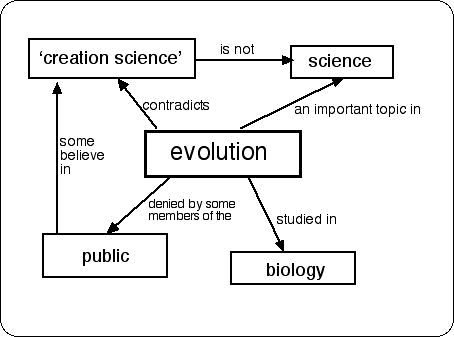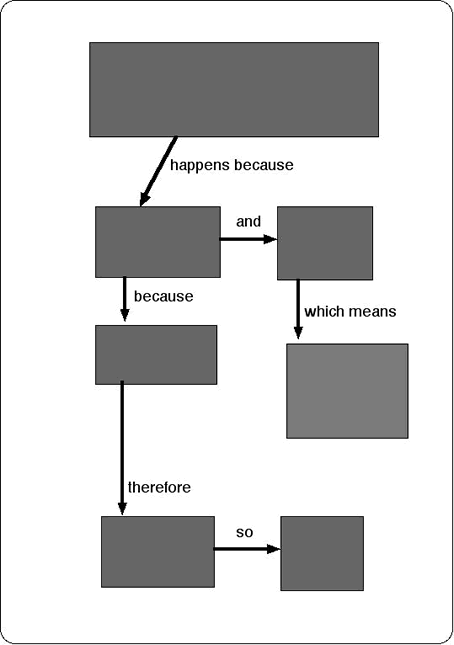| |
This activity asks students to respond
to common public objections to the high
level of scientific confidence in the
theory of evolution by natural selection
|
|
| Overview of the activity |
| |
Activity 7 was set
in the context of scientists needing to communicate
about their work to the public. Activity 8 develops
this link (“It is the responsibility of scientists
to explain our work to the public who ultimately
fund our research”), and concerns public unease
with ‘gene technology’, and more extreme views
about the status of evolution (i.e. by natural
selection) as a scientific theory. Students, working
in groups, are asked to suggest how to respond
to a letter from a pressure group (CAMMUL – the
campaign against man-made unnatural life!) which
denies that life on earth could have evolved:
“Please read the arguments put forward by CAMMUL
carefully, and think about how we can counter
these arguments. You need to identify each of
the points that CAMMUL are making, and identify
what scientific ideas or information need to be
used to challenge each point.”
During the ASCEND project this activity, and the
preceding one, were undertaken by groups of students
during the same 90 minute sessions. They may easily
be separated and used independently.
|
| |
| Rationale of the activity |
| |
As with the previous
activity, this activity is set in the context of
the public understanding of science. Also, as with
the previous activity, the topic (natural selection)
has been chosen because experience suggests that
even able students may fail to see the ‘whole picture’
and take away from school science a partial understanding
of the key arguments used to support evolutionary
theory. As the students are told in the briefing
information: “the reasons so many people doubt evolution
are that (a) it has occurred over such a long time
scale, and (b) evolution only makes sense when someone
understands how a number of separate key ideas fit
together”.
This activity, then, develops ideas from previous
ASCEND activities on the need to integrate different
ideas (Activity 7), and the nature of a scientific
explanation (Activity 4), as well as – like most
of the ASCEND activities - involving team work and
a form of modelling activity.
The activity is set within a ‘science and public
affairs’ context. Ignor Raymus, the chair of CAMMUL
(the pressure group ‘Campaign Against Man-Made Unnatural
Life’) has written to the SynBot Institute to raise
public concerns about “work that is described as
‘genetic engineering’, where you try to change the
natural structure of living things, and create new
un-natural plants that may lead to all sorts of
unforeseen problems” - a “type of ‘research’ … based
on the widely discredited ‘theory of evolution’
which is now recognised to be a scientific theory
which is confused, mistaken and contradicted by
evidence available to anyone who chooses to look
around them and think about the natural world.”
Ignor Raymus then sets out some arguments against
evolution. These are based on common objections
that are raised, and which may appeal to ‘common
sense’: |
| |
• something like
a green plant, with all its complex structure, could
not possibly come about by chance
• there is so much variety in living things that
they cannot possibly be derived from common
ancestors
• left to their own devices, living things are not
going to breed to ‘improve’ the species
• no one has ever managed to breed sheep from dogs,
no matter how much they have selected the parents
• parents always leave offspring of the same type
• if man had evolved from monkeys, then why are
there still monkeys?
• why do the genes for some diseases seem to get
passed on so effectively? |
| |
| Responding to these
objections with sound arguments requires a good
understanding of the theory of evolution by natural
selection! |
| |
| Resources |
| |
In ASCEND the students
were not required to produce any particular form
of output in this activity, although there are materials
and hints suggesting two complementary approaches.
Teachers using these materials in other contexts
may wish to make the activity more prescriptive.
The important learning principles are that students
are being asked to actively process and organise
information to encourage meaningful learning; and
that by working in small groups, focused dialogue
- with sharing and exchanging of ideas - is encouraged.
The groups are provided with a set of cards labelled
with possibly relevant concepts (‘species’, ‘variation’,
‘mutation’ etc.), and are provided with an example
of a simple concept map type schematic:- |
| |
 Figure 8.1:
example of a simple concept map
Figure 8.1:
example of a simple concept map
|
| |
Building a concept map
to model how key ideas link is one way of showing
how scientific ideas build into extended networks.
Figure 8.1 is provided as a model (the caption in
the student materials is ‘mapping out related concepts’).
However, this would not in itself make an argument
for accepting evolutionary theory as reliable knowledge.
The second suggested format, is a graphical representation
of the argument in a form more like a flow chart
(Figure 8.2), which is modelled for the students
in one of the hand-outs (with the caption ‘structuring
an argument’). |
| |
 Figure 8.2:
Figure 8.2: Schematic for representing
an argument
|
| |
| The groups are provided with a set
of ‘evocards’, each offering some information/evidence
about how scientists understand evolutionary ideas.
A few of the examples provided are: |
| |
• In most living things parents
produce many offspring, but only a few survive to
adulthood.
• The fossil record shows that there were many types
of living things (e.g. the dinosaurs) that are now
extinct. If a species
fits its environment well, and the environment remains
much the same, that species may hardly change in
many, many millions of years – e.g. crocodilians.
• All living things alive today share similar genetic
codes.
• Etc. |
| |
| These ideas are suitable
for being organised into a similar schematic to
that shown in Figure 8.2. There are sufficient cards
to provide an excess of examples and ideas, so that
there is considerable flexibility in terms of possible
creditable outcomes. As with most of the ASCEND
teaching resources, it is possible for teachers
to adopt the materials in their original form, or
to modify the original by changing, adding or omitting
items to best meet the needs of different groups. |
| |
| The following resources
are included on the CD: |
| |
| Resource |
Description |
Filename |
| A Serious Challenge
to Science |
Memo from the Director,
SynBot Institute for Plant
Sciences, setting out challenge |
Act
8 memo |
| For Nature – Against
Unnatural Science |
Letter from the
pressure group ‘Cammul’ to be
addressed by the team. |
Act
8 letter |
| Mapping out related
concepts |
Model of a single
concept map, as an example of
how ideas may be linked graphically |
Act
8 map |
| Concept cards |
Set of concept
terms that can be used to construct
a concept map
(Best printed as one A4 page,
and cut into cards) |
Act
8 concepts |
| Structuring an
argument |
Model of how an
argument may be structured graphically
|
Act
8 argument |
| Evocards |
A set of pages
with ideas/evidence that can be
considered when developing an
argument for life on Earth to
have evolved by natural selection.
(The document is set up with one
card per page, but should be printed
with several (e.g. 6) cards per
A4 page.) |
Act
8 ideas |
|
|
|
| |
| Groups will also need
poster paper, glue etc., if asked to produce a permanent
record of their ideas. Concept cards and ‘evocards’
should be provided as pre-cut sets (ideally with
each set in a labelled enveloped): otherwise groups
will also need scissors. |
| |
| Download
PDF of activity 8 brief |
| |
|